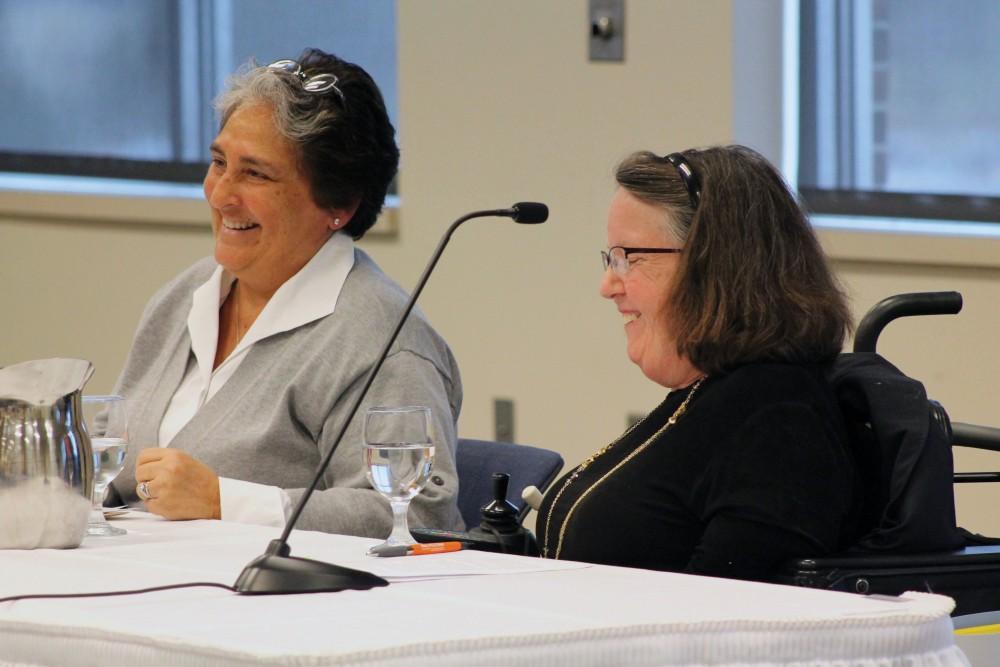Discussion on donors continues

GV / Emily Frye Chair of the GVSU Board of Trustees Shelley Padnos (left) and Current Board of Trustees member, and former chair, Kate Pew Wolters (right)
Apr 6, 2014
Board of Trustees members joined in the discussion about donor relations at Grand Valley State University during a second town hall meeting held by the Student Senate on Thursday.
Shelley Padnos, chair of the Board of Trustees, and Kate Pew Wolters, the former chair and a current member of the board, shared their views with more than 50 members of the campus community including students, staff, faculty and administrators.
“We wanted to send a clear message throughout the university that conversations on controversial topics are not taboo or out of bounds,” Padnos said. “In fact we wanted to encourage this civil discourse and we both feel that this particular topic is worthy of conversation and further thought.”
Padnos and Pew Wolters spoke as individuals and as donors, and they said their views do not necessarily represent the administration’s. The pair started by answering students’ questions that were left from the first town hall meeting held in February.
One concern that was brought up is that donors affect the curriculum being taught at the university. At GVSU, new programs and those that are being cut must go through Provost Gayle Davis and the Board of Trustees.
“I would be willing to bet you that 95 percent of the donors couldn’t tell you Gayle Davis’s name,” Padnos said. “I can assure you that the driving force behind curriculum change has been students and students’ demand and need.”
Students also had said they would like to see more Laker community members recognized for their contributions, and it was suggested that more things be named after alumni or faculty who have positively affected the university. The LGBT Resource Center was listed as an example as it is going to be named after Milton Ford, who founded the center and was a professor at GVSU.
“I think it’s perfectly reasonable to expect that to happen in any given situation whether it’s a building or it’s a program or it’s a lecture series,” Pew Wolters said.
However, this is not a simple request. As state funding has decreased, the university has had to rely more on private donations, which can be boosted with certain techniques.
“The fact remains that with a lot of buildings, we have to raise money for a lot of the expenses,” Pew Wolters said. “We do go to donors, and that helps us to raise money if we’re willing to put a name somewhere. The state is not supporting us the way that they used to support us, and we now are required to try and find those funds elsewhere.”
The Mary Idema Pew Library was a $65 million project. Private donations accounted for $25 million of the funding. The L. William Seidman Center, which cost $42 million, did not receive any money from the state. Almost 60 percent of the funds came from donations, which totaled about $25 million.
Another concern that was voiced to the senate was that naming has become an excessive practice at GVSU. The library was listed as an example.
“Each corridor, each floor and classrooms are named after individual people, and we also have spaces in the library named after corporations,” said Ricardo Benavidez, president of the senate. “Some students feel the excessive amount of names on spaces has become detrimental to studying and learning, that it has become a distraction.”
The third floor of the library is named after Pew Wolters. Also on the third floor is the Padnos & Sarosik Reading Room. Padnos shared the story of the first time the pair viewed the library.
“We looked at the first floor then got in the elevator and went to the next floor. The next floor happens to be named after Kate and we got off and ‘whoa,’” Padnos said. “Her name is in really, really big letters.”
When they viewed the Padnos Greeting Room, Padnos recalls Pew Wolters saying, “Thank God your name is as big as mine.”
Both agreed that the university could look at alternative ways of recognizing donors, such as a donor wall.
“The bottom line is different people give for different reasons,” Pew Wolters said. “There is no doubt that some people give to get their name big on a wall. Is that wrong when the ultimate result is a great building or great whatever? I suppose that’s up for philosophers to debate. We all probably have different feelings about that, and other people just give because they are proud about the institution that Grand Valley has become.”























